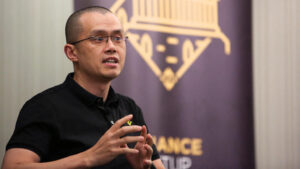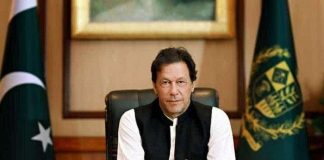DECEMBER 9, 2022

Changpeng Zhao, the founder and chief executive of Binance, was part of a group chat on Signal with key crypto leaders as the rival exchange FTX collapsed. – Costas Baltas/Reuters
The day before the embattled cryptocurrency exchange FTX filed for bankruptcy, Changpeng Zhao, the chief executive of the rival exchange Binance, sent an alarmed text to Sam Bankman-Fried, FTX’s founder.
Mr. Zhao was concerned that Mr. Bankman-Fried was orchestrating crypto trades that could send the industry into a meltdown. “Stop now, don’t cause more damage,” Mr. Zhao wrote in a group chat with Mr. Bankman-Fried and other crypto executives on Nov. 10. “The more damage you do now, the more jail time.”
FTX and its sister hedge fund, Alameda Research, had just collapsed after a run on deposits exposed an $8 billion hole in the exchange’s accounts. The implosion unleashed a crypto crisis, as firms with ties to FTX teetered on the brink of bankruptcy, calling the future of the entire industry into question.
The series of about a dozen group texts between Mr. Zhao and Mr. Bankman-Fried on Nov. 10, which were obtained by The New York Times, show that key crypto leaders feared that the situation could get even worse. And their frantic communications offer a rare glimpse into the unusual way business is conducted behind the scenes in the industry, with at least three top officials from rival companies exchanging messages in a group chat on the encrypted messaging app Signal.

Sam Bankman-Fried, FTX’s founder, spoke at The New York Times’s DealBook Summit last month. He is under investigation by regulators for FTX’s implosion. – Hiroko Masuike/NY Times
The texts also show that industry leaders were acutely aware that the actions of a single firm or fluctuations in the value of one virtual currency could destabilize the whole industry. The exchanges became increasingly tense as Mr. Bankman-Fried and Mr. Zhao traded barbs.
Earlier that week, Mr. Zhao had agreed to buy FTX and save the exchange, before backing out of the deal. In the Nov. 10 texts, he appeared certain that FTX would not survive, and concerned that it could bring the rest of the industry down with it. During a crypto crash in May, two currencies had plunged in value, setting off an industrywide meltdown and forcing several prominent firms into bankruptcy.
In the Nov. 10 texts, Mr. Zhao specifically accused Mr. Bankman-Fried of using his hedge fund to drive down the price of Tether, a so-called stablecoin whose price is designed to remain at $1. According to messages seen by The Times and people familiar with the matter, the group chat included several other prominent crypto executives, including Jesse Powell, a founder of the crypto exchange Kraken, and Paolo Ardoino, the chief technology officer of Tether, the company that issues the stablecoin of the same name.
Tether is a linchpin of crypto trading worldwide, commonly used by digital asset enthusiasts to conduct transactions. Industry insiders have long feared that if Tether’s price fell, it would cause a domino effect that might bring the industry to its knees. (Tether ultimately did not end up losing its $1 peg.)
A spokeswoman for Binance declined to comment on the text exchanges. A spokeswoman for Kraken declined to comment.
Mr. Bankman-Fried, 30, said in a statement that Mr. Zhao’s claims were “absurd.”
“Trades of that size would not make a material impact on Tether’s pricing, and to my knowledge neither myself nor Alameda has ever attempted to intentionally depeg Tether or any other stablecoins,” he said. “I have made a number of mistakes over the past year but this is not one of them.”
A spokeswoman for Tether said in a statement that the company had “demonstrated its resilience to attacks.” She added that FTX’s actions “don’t reflect the ethos and commitment of an entire industry.”
FTX, a marketplace where people could buy and sell digital currencies, collapsed early last month when customers rushed to withdraw deposits, partly in response to tweets by Mr. Zhao that called the company’s finances into question. FTX soon folded, setting off investigations by the Justice Department and the Securities and Exchange Commission into whether the crypto exchange broke the law by using its customers’ funds to prop up Alameda.
The Justice Department is also investigating whether Mr. Bankman-Fried engaged in market manipulation in the spring by making trades that contributed to the failure of two prominent cryptocurrencies.
For years, critics of the crypto industry have said Tether could also be vulnerable to a collapse. Tether has long claimed that its stablecoins are backed by cash and other traditional assets, and that in a crisis, all of its customers could redeem their coins for the equivalent amount in dollars. But regulators have previously accused Tether of lying about the status of its reserves, sowing doubts about the coin’s reliability.
Mr. Bankman-Fried was once a major Tether customer. Before he agreed to the deal with Binance, he met with a top Tether official in the Bahamas, where FTX was based, and asked for billions in funding to prop up his exchange, a person with knowledge of the matter said. Tether declined to help, the person said.
In one of the Nov. 10 messages to the group, Mr. Zhao pointed out a $250,000 trade by Alameda that he said was intended to destabilize Tether. The trade was visible on the blockchain, a public ledger of cryptocurrency transactions that anyone can view.
In response to Mr. Zhao’s accusations, Mr. Bankman-Fried seemed nonplused. “Huh?” he said. “What am I doing to stablecoins?”
“Are you claiming that you think that $250k of USDT trading would depeg it?” he added, using a common shorthand to refer to the Tether currency.
Mr. Zhao responded that he didn’t think a trade of that size would succeed in destroying Tether, but that it could still cause problems.
“My honest advice: stop doing everything,” Mr. Zhao said. “Put on a suit, and go back to DC, and start to answer questions.”
“Thanks for the advice!” Mr. Bankman-Fried shot back.
Courtesy/Source: The NY Times









































































































